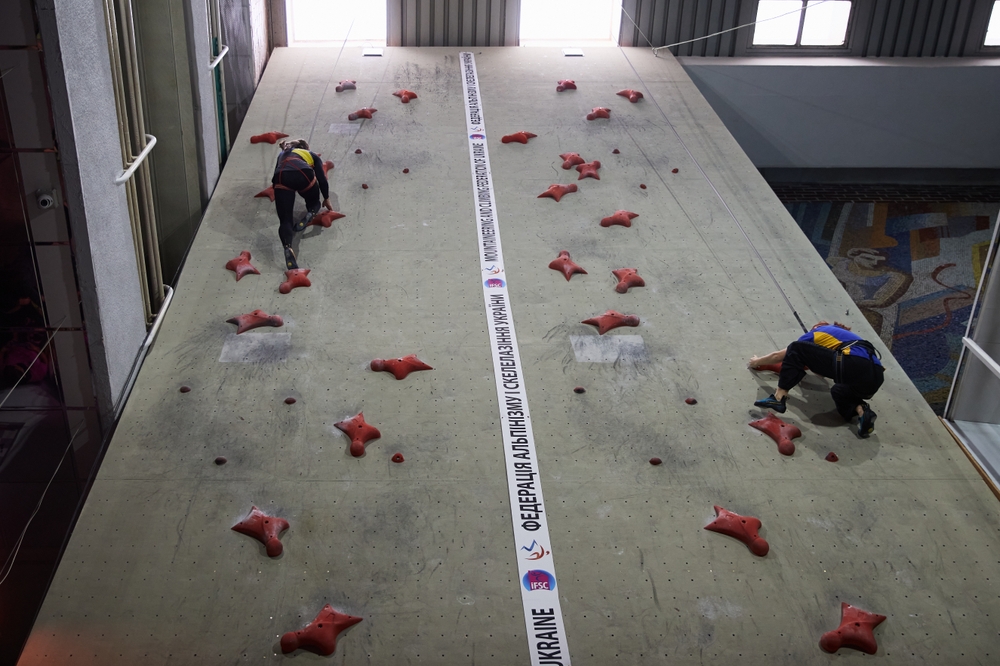Bouldering: The Vertical Chess Game of Rock Climbing
In the world of rock climbing, a unique discipline has been gaining momentum, captivating both seasoned climbers and newcomers alike. Bouldering, often described as a vertical chess game, combines physical prowess with mental acuity in a way that few other sports can match. This intense, problem-solving activity pushes climbers to their limits, both physically and mentally, as they navigate short but challenging routes without ropes or harnesses.

The Origins and Evolution of Bouldering
Bouldering’s history is intertwined with the broader narrative of rock climbing. In the late 1800s, climbers in Europe, particularly in areas like Fontainebleau, France, began practicing on smaller rock formations to hone their skills for larger alpine ascents. This practice, initially viewed as mere training, gradually evolved into a distinct discipline.
The term “bouldering” itself is attributed to British climber Oscar Eckenstein, who advocated for its value in developing climbing technique in the early 20th century. However, it wasn’t until the 1960s and 1970s that bouldering began to gain recognition as a standalone activity, largely due to the efforts of American climber John Gill. Gill, often called the father of modern bouldering, brought a gymnastic approach to the discipline, emphasizing dynamic movements and introducing the concept of “problems” – specific sequences of moves on a boulder.
As bouldering gained popularity, it began to develop its own culture and ethos. The 1990s saw a surge in interest, with the establishment of indoor bouldering gyms and the organization of competitive events. This period also witnessed significant advancements in equipment, particularly in climbing shoe technology and crash pad design, making the sport safer and more accessible.
Today, bouldering stands as a fully-fledged competitive sport, included in the Olympic Games since Tokyo 2020. Its evolution from a training method to an Olympic discipline reflects the sport’s growing appeal and the recognition of its unique challenges and skills.
The Art and Science of Bouldering Technique
At its core, bouldering is about solving vertical puzzles with your body. Each route, or “problem,” presents a unique set of challenges that require a combination of physical strength, flexibility, balance, and mental acuity to overcome. Unlike traditional rope climbing, bouldering focuses on short, intense sequences of moves, typically on rock faces no higher than 20 feet.
The techniques employed in bouldering are diverse and constantly evolving. Fundamental moves include crimps (gripping tiny edges with fingertips), slopers (open-handed grips on rounded holds), and dynos (dynamic jumping moves). Advanced techniques like heel hooks, toe hooks, and drop knees allow climbers to maintain body tension and navigate complex sequences.
One of the most critical aspects of bouldering technique is body positioning. Climbers must constantly adjust their center of gravity, using subtle shifts in weight and body tension to maintain balance on the wall. This often involves counterintuitive movements, such as keeping the hips close to the wall or using opposing forces to create stability.
Footwork is equally crucial in bouldering. Precise foot placement allows climbers to distribute weight effectively, reducing the strain on their arms and enabling more efficient movement. Advanced footwork techniques like smearing (using friction on bare rock) and flagging (using a leg for balance) are essential skills in a boulderer’s repertoire.
The mental aspect of bouldering cannot be overstated. Each problem requires careful analysis and strategizing. Climbers must read the route, visualize their movements, and often try multiple approaches before successfully completing a problem. This problem-solving element is what leads many to compare bouldering to a vertical game of chess.
Training for Bouldering: A Holistic Approach
Effective training for bouldering requires a multifaceted approach that addresses both physical and mental aspects of the sport. Physical preparation focuses on developing strength, power, flexibility, and endurance specific to climbing movements.
Finger strength is paramount in bouldering, as climbers often rely on tiny holds to support their body weight. Training tools like hangboards and campus boards are widely used to develop grip strength and contact strength (the ability to grip holds instantly upon contact). However, this training must be approached cautiously to avoid injury to the delicate finger tendons.
Core strength is another crucial component of bouldering fitness. A strong core enables climbers to maintain body tension and execute complex movements. Exercises like planks, leg lifts, and TRX workouts are commonly incorporated into training regimens.
Flexibility training is often overlooked but is essential for bouldering success. Increased flexibility allows climbers to reach distant holds, maintain efficient body positions, and execute advanced techniques like high steps and drop knees. Yoga and dynamic stretching routines are popular among boulderers for improving flexibility and body awareness.
Cardiovascular fitness, while less critical than in other climbing disciplines, still plays a role in bouldering performance. High-intensity interval training (HIIT) can be particularly beneficial, mimicking the short, intense bursts of effort required in bouldering.
Mental training is equally important. Visualization techniques, where climbers mentally rehearse their movements before attempting a problem, are widely used. Mindfulness practices can help climbers stay focused and manage stress during challenging climbs. Additionally, working on problem-solving skills through puzzles or strategy games can enhance a climber’s ability to read and interpret boulder problems.
The Bouldering Community and Culture
One of the most appealing aspects of bouldering is its strong sense of community. Unlike many individual sports, bouldering often involves a collaborative atmosphere where climbers work together to solve problems, share beta (information about climbs), and encourage each other.
This communal aspect is evident in the practice of “spotting,” where fellow climbers stand ready to guide a falling climber safely onto crash pads. It’s also seen in the tradition of “beta spraying,” where climbers enthusiastically share advice on how to complete a problem, sometimes to the point of mild annoyance for those who prefer to figure things out independently.
Bouldering culture has its own unique ethos and terminology. Concepts like “sending” (successfully completing a problem), “projects” (problems a climber is working on over time), and “flash” (completing a problem on the first attempt with prior knowledge) are fundamental to the bouldering lexicon.
The sport has also developed its own grading systems to indicate the difficulty of problems. The most widely used are the V-Scale in North America and the Font Scale in Europe. These systems allow climbers to gauge their progress and choose problems appropriate to their skill level.
Bouldering competitions have become increasingly popular, with events ranging from local gym competitions to international contests like the IFSC Bouldering World Cup. These competitions not only showcase the world’s top talents but also serve as gathering points for the bouldering community, fostering connections and pushing the boundaries of what’s possible in the sport.
Environmental and Ethical Considerations in Bouldering
As bouldering has grown in popularity, it has faced increasing scrutiny regarding its environmental impact. The concentration of climbers in popular bouldering areas can lead to erosion, vegetation damage, and disturbance of wildlife habitats. This has led to efforts within the climbing community to promote responsible practices and minimize impact.
Leave No Trace principles are widely adopted in bouldering. These include staying on established trails, properly disposing of waste, and respecting wildlife. Many bouldering areas now have designated camping spots and toilet facilities to manage human impact.
The use of chalk, a staple in climbing for improving grip, has been a point of contention due to its visible residue on rocks. Some areas have implemented restrictions on chalk use or encouraged the use of colored chalk that blends with the rock. Innovations in eco-friendly chalk alternatives are also being explored.
Another ethical consideration in bouldering is the practice of “chipping” or artificially altering rock to create or enhance holds. This practice is widely condemned in the bouldering community, as it permanently changes the natural environment and is seen as unsportsmanlike.
Access issues are a constant concern in the bouldering world. As the sport grows, there’s increased pressure on land managers and property owners to regulate or restrict climbing access. Climbing organizations like the Access Fund in the United States work to maintain open access to climbing areas while promoting responsible use.
The development of new bouldering areas also raises ethical questions. While discovering and developing new problems is an exciting aspect of the sport, it must be balanced with respect for local ecosystems and cultural sites. Many climbing communities now have protocols for establishing new areas, including consultation with local authorities and environmental assessments.
The Future of Bouldering: Trends and Innovations
As bouldering continues to evolve, several trends and innovations are shaping its future. One significant development is the increasing focus on urban bouldering. Cities around the world are incorporating climbing walls into public spaces, making the sport more accessible to urban populations. These installations range from simple traverse walls in parks to elaborate bouldering structures integrated into building designs.
Technology is playing an increasingly important role in bouldering. Climbing apps allow users to log their ascents, find new problems, and connect with other climbers. Wearable technology is being developed to track climber’s movements and provide data on performance metrics like grip strength and body positioning.
In competitive bouldering, we’re seeing a trend towards more dynamic and spectacular movements. Problems in competitions are increasingly designed to showcase athletic prowess and create exciting spectator experiences. This trend is influencing outdoor bouldering as well, with climbers pushing the boundaries of what’s possible in terms of dynamic movements on natural rock.
Climate change is having a significant impact on bouldering, affecting access to certain areas due to changing weather patterns and increased risk of wildfires. This has led to a growing awareness within the climbing community about environmental issues and efforts to make the sport more sustainable.
The inclusion of bouldering in the Olympics has brought increased attention and resources to the sport. This is likely to accelerate its growth and potentially lead to more structured development pathways for young climbers. However, it also raises questions about maintaining the sport’s core values and connection to nature as it becomes more mainstream and commercialized.
Advancements in climbing wall design and hold manufacturing are allowing for increasingly complex and varied indoor bouldering experiences. Some gyms are experimenting with adjustable walls that can change angle and shape, providing endless possibilities for problem setting.
There’s also a growing interest in the intersection of bouldering with other disciplines. Cross-training with sports like gymnastics, parkour, and martial arts is becoming more common, influencing bouldering styles and training methods.
The Physical and Mental Health Benefits of Bouldering
Beyond its appeal as a sport and recreational activity, bouldering offers significant health benefits, both physical and mental. From a physical standpoint, bouldering provides a full-body workout that engages multiple muscle groups simultaneously. It’s particularly effective for developing upper body and core strength, as well as improving flexibility and balance.
The nature of bouldering movements, which often involve isometric holds and explosive power, can lead to improvements in muscular endurance and power. The sport also promotes bone density and joint health, as the impact of climbing and landing provides beneficial stress to the skeletal system.
Cardiovascular health benefits from bouldering as well. While not typically considered an aerobic activity, the intense bursts of effort required in bouldering can provide an effective form of interval training, improving heart health and overall fitness.
Perhaps even more notable are the mental health benefits associated with bouldering. The problem-solving aspect of the sport engages the mind in a way that few other physical activities do. This cognitive engagement, combined with physical exertion, can be highly effective in reducing stress and improving mood.
Several studies have explored the potential of bouldering as a therapeutic tool for mental health conditions. Research has shown promising results in using bouldering to treat depression, anxiety, and ADHD. The combination of physical activity, focus, and social interaction appears to have a powerful positive impact on mental well-being.
Bouldering also fosters qualities like perseverance, self-confidence, and risk management. The process of working on a challenging problem, experiencing failure, and eventually succeeding can be a powerful metaphor for overcoming obstacles in other areas of life.
The social aspect of bouldering contributes significantly to its mental health benefits. The supportive community and collaborative nature of the sport can help combat feelings of isolation and build social connections, which are crucial for mental health.
Bouldering for All: Accessibility and Inclusivity
One of the most exciting developments in the world of bouldering is the growing focus on making the sport accessible and inclusive to a wider range of participants. Efforts are being made to break down barriers and create opportunities for people of all ages, abilities, and backgrounds to experience the joys and benefits of bouldering.
Adaptive bouldering is an area that has seen significant growth in recent years. Climbing gyms and outdoor areas are increasingly being designed or modified to accommodate climbers with physical disabilities. Specialized equipment and techniques have been developed to enable climbers with various impairments to participate fully in the sport.
The bouldering community is also working to address issues of diversity and representation. Initiatives aimed at introducing bouldering to underrepresented communities are becoming more common, with organizations offering programs specifically designed to make the sport more accessible to people of color, LGBTQ+ individuals, and those from lower-income backgrounds.
Age is no barrier in bouldering, with participants ranging from young children to seniors. Many climbing gyms offer programs tailored to different age groups, recognizing that the physical and mental benefits of bouldering can be valuable at any stage of life.
The growth of indoor bouldering facilities has played a crucial role in making the sport more accessible. These gyms provide a controlled environment where beginners can learn safely and experienced climbers can train year-round, regardless of weather conditions or proximity to natural bouldering sites.
Education and outreach programs are increasingly focusing on introducing bouldering to schools and community centers. These initiatives not only provide physical education opportunities but also use bouldering as a tool for teaching problem-solving skills, teamwork, and self-confidence.
Conclusion: The Enduring Appeal of Bouldering
As we’ve explored throughout this article, bouldering is far more than just a physical activity or sport. It’s a complex and multifaceted pursuit that challenges the body and mind in equal measure. From its humble origins as a training tool for mountaineers to its current status as an Olympic sport and global phenomenon, bouldering has continually evolved while maintaining its core essence.
The unique combination of physical challenge, mental engagement, and community spirit makes bouldering a truly special activity. It offers a way to connect with nature, push personal limits, and forge strong bonds with fellow enthusiasts. The problem-solving aspect of the sport provides a constant source of novelty and challenge, ensuring that even the most experienced climbers always have new heights to reach.
As bouldering continues to grow and develop, it faces both opportunities and challenges. The increasing popularity of the sport brings with it the need for responsible stewardship of climbing areas and thoughtful consideration of its environmental impact. At the same time, technological innovations and a growing body of research are opening up new possibilities for training, performance, and therapeutic applications.
The future of bouldering looks bright, with potential for further growth in competitive scenes, recreational participation, and therapeutic use. As the sport becomes more accessible and inclusive, it has the power to positively impact an even wider range of individuals, promoting physical health, mental well-being, and a deep appreciation for the natural world.
Ultimately, the enduring appeal of bouldering lies in its simplicity and complexity. At its core, it’s about the pure challenge of moving over rock, using nothing but one’s own strength, skill, and determination. Yet within this simple premise lies an infinite variety of movements, problems, and experiences. It’s this blend of accessibility and depth that continues to draw people to bouldering, making it not just a sport, but a lifelong pursuit and passion.





